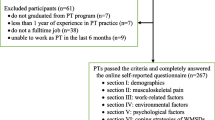Abstract
Introduction Athletic trainers often work for elongated and irregular hours or days, and need to react in emergency situations. These professionals are at risk for work-related musculoskeletal disorders (WMSDs). This study investigated the WMSDs experienced by athletic trainers (ATs), plus related personal and occupational factors. Methods A customized questionnaire with subject’s demographic and WMSDs information was constructed and administered in all accessible ATs in Taiwan. In addition to descriptive analysis of demographics and WMSDs, the relationship between personal/occupational-related factors and WMSD symptoms were also evaluated. Results A total of 146 effective questionnaires were returned. The results indicated that a 48.5% prevalence rate of athletic trainers in Taiwan, and these disorders are mainly located in low back (42%), finger (38%) and shoulder (26%) regions. Logistic regression revealed that average work hour (odds ratio (OR) = 1.834, 95% confidence interval (CI): 1.066–3.156) and continue education participation (OR = 0.346, 95% CI: 0.140–0.854) were the most significant predictors for WMSDs occurrence. Performing taping was the most significant predictor for the low back (OR = 28.274, 95% CI: 2.568–311.423) and finger (OR = 19.535, 95% CI:2.273–167.912) symptoms; while performing providing first aid (OR = 12.128, 95% CI:3.881–37.899) was the most significant predictor for the shoulder’s. Conclusion This study revealed that athletic trainers in Taiwan area suffered from high rate of WMSDs, and the relationship between WMSDs and specific job features were reported. Preventive and therapeutic modifications of the work environment to decrease the occurrence of WMSDs are in need for athletic trainers and other similar professions. Further research examining safe patient handling ergonomics, proper equipment in the context of athletic training and professional development strategies must be pursued.
Similar content being viewed by others
References
Judd MR, Perkins SA. Athletic training education program directors’ perceptions on job selection, satisfaction, and attrition. J Athl Train. 2004;39(2):185–92.
Forde MS, Punnett L, Wegman DH. Pathomechanisms of work-related musculoskeletal disorders: Conceptual issues. Ergonomics. 2002;45(9):619–30.
Ando S, Ono Y, Shimaoka M, Hiruta S, Hattori Y, Hori F, et al. Associations of self estimated workloads with musculoskeletal symptoms among hospital nurses. Occup Environ Med. 2000;57(3):211–6.
Trinkoff AM, Lipscomb JA, Geiger-Brown J, Brady B. Musculoskeletal problems of the neck, shoulder, and back and functional consequences in nurses. Am J Ind Med. 2002;41(3):170–8.
Eriksen W. The prevalence of musculoskeletal pain in Norwegian nurses’ aides. Int Arch Occup Environ Health. 2003;76(8):625–30.
Smith DR, Ohmura K, Yamagata Z, Minai J. Musculoskeletal disorders among female nurses in a rural Japanese hospital. Nurs Health Sci. 2003;5(3):185–8.
Smith DR, Wei N, Kang L, Wang RS. Musculoskeletal disorders among professional nurses in mainland China. J Prof Nurs. 2004;20(6):390–5.
Smith DR, Wei N, Zhao L, Wang RS. Musculoskeletal complaints and psychosocial risk factors among Chinese hospital nurses. Occup Med. 2004;54(8):579–82.
Holder NL, Clark HA, DiBlasio JM, Hughes CL, Scherpf JW, Harding L, et al. Cause, prevalence, and response to occupational musculoskeletal injuries reported by physical therapists and physical therapist assistants. Phys Ther. 1999;79(7):642–52.
Cromie JE, Robertson VJ, Best MO. Work-related musculoskeletal disorders and the culture of physical therapy. Phys Ther. 2002;82(5):459–72.
Cromie JE, Robertson VJ, Best MO. Work-related musculoskeletal disorders in physical therapists: Prevalence, severity, risks, and responses. Phys Ther. 2000;80(4):336–51.
Salik Y, Ozcan A. Work-related musculoskeletal disorders. A survey of physical therapists in Izmir-Turkey. BMC Musculoskelet Disord. 2004;5:art. no.27.
Bork BE, Cook TM, Rosecrance JC, Engelhardt KA, Thomason MEJ, Wauford IJ, et al. Work-related musculoskeletal disorders among physical therapists. Phys Ther. 1996;76(8):827–35.
West DJ, Gardner D. Occupational injuries of physiotherapists in North and central Queensland. Aust J Physiother. 2001;47:179–86.
Cuppett M, Latin RW. A survey of physical activity levels of certified athletic trainers. J Athl Train. 2002;37(3):281–5.
Balogun JA, Titiloye V, Balogun A, Oyeyemi A, Katz J. Prevalence and determinants of burnout among physical and occupational therapists. J Allied Health. 2002;31:131–9.
Campbell DC, Miller MH, Robinson WW. The prevalence of burnout among athletic trainers. J Athl Train. 1985;20:110–3.
Capel SA. Psychological and organizational factors related to burnout in athletic trainers. Res Q Exerc Sport. 1986;57(4):321–8.
Capel SA. Attrition of athletic trainers. J Athl Train. 1990;25:34–9.
Gieck J, Brown RS, Shank RH. The burnout syndrome among athletic trainers. J Athl Train. 1982;17:36–42.
McLaine AJ. An overview of burnout in athletic trainers. Athletic Therapy Today. 2005;10(6):11–3.
Capel SA, Sisley BL, Desertrain GS. The relationship of role conflict and role ambiguity to burnout in high school basketball coaches. Int J Sport Psychol. 1987;9(2):106–17.
Meltzer LS, Huckabay LM. Critical care nurses’ perceptions of futile care and its effect on burnout. Am J Crit Care. 2004;13(3):202–8.
Smith DR, Leggat PA. Musculoskeletal disorders among rural Australian nursing students. Aust J Rural Health. 2004;12(6):241–5.
Prentice WE. Bandaging and taping. In: Prentice WE, editor. Arnheim’s principles of athletic training. 13th ed. New York: McGraw-Hill; 2008. p. 235–66.
Perrin DH. Athletic taping and bracing. Champaign, IL: Human kinetics; 1995.
Lusted MJ, Carrasco CL, Mandryk JA, Healey S. Self reported symptoms in the neck and upper limbs in nurses. Appl Ergon. 1996;27(6):381–7.
Yip YB. A study of work stress, patient handling activities and the risk of low back pain among nurses in Hong Kong. J Adv Nurs. 2001;36(6):794–804.
Darragh AR, Huddleston W, King P. Work-related musculoskeletal injuries and disorders among Occupational and physical therapists. Am J Occup Ther. 2009;63(3):351–62.
Scholey M, Hair MD. The problem of back pain in physiotherapists. Physiotherapy Practice. 1989;5(4):183–92.
Hosmer D, Lemeshow S (eds.): Solutions manual to accompany applied logistic regression, 2nd edn. London: Wiley-Interscience Publication; 2001.
Conflict of interest
The authors did not have any financial and personal relationship with other people or organization that could inappropriately influence this work.
Author information
Authors and Affiliations
Corresponding author
Rights and permissions
About this article
Cite this article
Ju, YY., Cheng, HY.K., Hsieh, YJ. et al. Work-Related Musculoskeletal Disorders in Athletic Trainer. J Occup Rehabil 21, 190–198 (2011). https://doi.org/10.1007/s10926-010-9268-y
Published:
Issue Date:
DOI: https://doi.org/10.1007/s10926-010-9268-y




